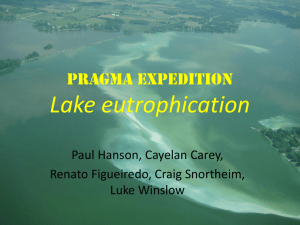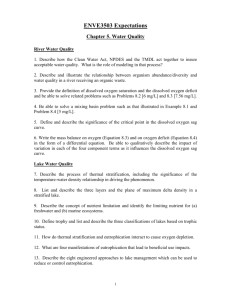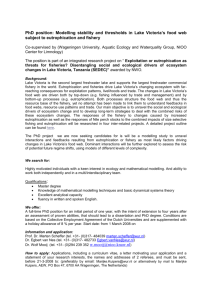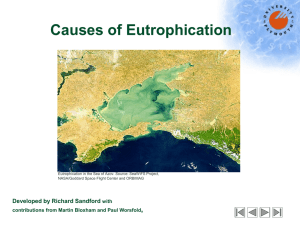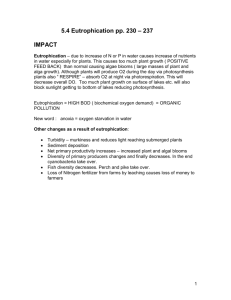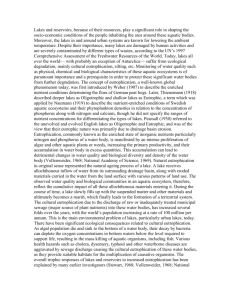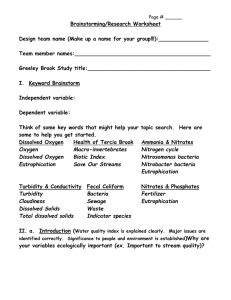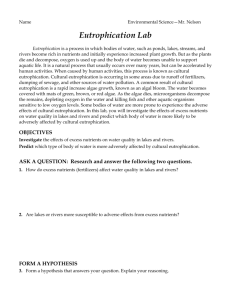Eutrophication in the St. Lawrence River
advertisement
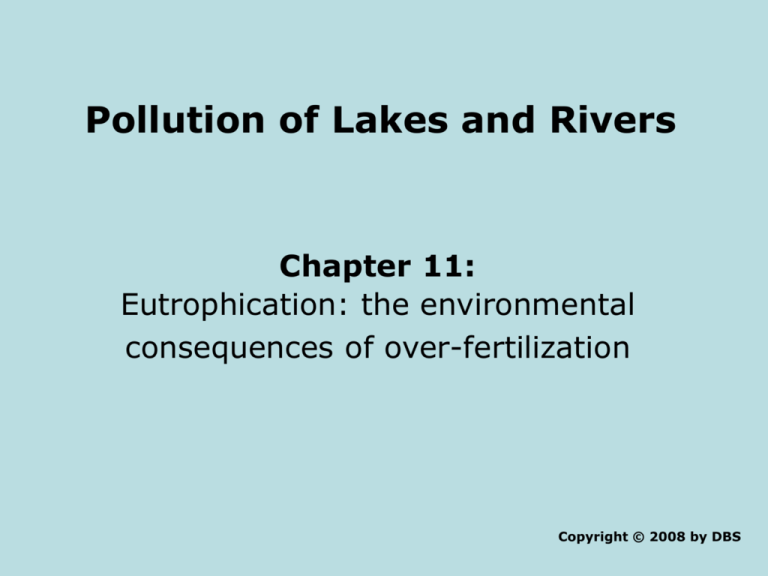
Pollution of Lakes and Rivers Chapter 11: Eutrophication: the environmental consequences of over-fertilization Copyright © 2008 by DBS Contents • • • • • • • • • • • • • • • • • • • • Definition and scope of the problem Inferring past nutrient levels The major symptoms of eutrophication Algal and Cyanobacterial (blue-green algal) blooms Excessive aquatic macrophyte growth Deepwater oxygen depletions Tracking past nutrient changes in rivers by using offshore sediments Eutrophication of estuaries a long-term history of Chesapeake Bay anoxia Separating the influence of nutrients from climate on a lake development Examining the effects of multiple Stressors on Prairie Lakes: a landscape analysis of long-term limnological change Impoundment and flooding: changes in trophic status due to reservoir formation Tracking changes in epilimnetic versus hypolimnetic conditions: an example of spatial decoupling of limnological processes in different lake strata Regional assessments of environmental change in lakes and reservoirs: the Environmental Monitoring and Assessment Program (EMAP) Extending regional assessments into the future: the value of surface sediments to long-term monitoring programs The role of macrophytes in lake dynamics: exploring the role of alternate equilibria in shallow lakes Lake Baikal: tracking recent environmental changes in a unique limnological setting Atmospheric deposition of nutrients: tracking nitrogen enrichment in seemingly pristine high alpine lakes Does eutrophication result in increased ecosystem variability and reduced predictability? Nutrient management using a combination of modeling and sedimentary approaches Linking evolutionary changes to shifts in trophic status Some important successes, but many new applications are possible Eutrophication Definition and Scope of the Problem • • Nutrient enrichment of water bodies Most common water-quality issue in the world (Schindler, 2006) Eutrophication Definition and Scope of the Problem Symptoms: - excessive phytoplankton blooms (e.g. cyanobacteria) - thick growths of aquatic macrophytes and periphyton - taste and odor problems - once this increased biomass dies and settles to the bottom of the water body where decomposition occurs, oxygen levels may become depleted thus killing off fish and other animals, releasing phosphorus from the sediments (i.e. internal loading), and a suite of other problems. Eutrophication Definition and Scope of the Problem Certain cyanobacteria can produce toxins that render water unsafe (Carmichael, 1994; 1997) Killed 16 cows on a farm near Baldur, Manitoba (Canada) in 1996. Eutrophication Definition and Scope of the Problem • • • 1960s-1970s causes were unknown Obviously nutrients but where from? Which industry? Vallentyne (1974) warned that lakes would become “algal bowls” (cf. dust bowls of 1930’s) ALGAL BOWL (2008) edition Cover Eutrophication Definition and Scope of the Problem Liebig’s Law: under steady state conditions, the growth of an organism is dependent on the amount of essential material that is available in least supply “you are only as strong as your weakest link” There can be too much… Shelford’s Law: different organisms can survive within a range of conditions, but have an ecological minimum and maximum which represent the limits of tolerance Eutrophication Definition and Scope of the Problem • Schindler’s (1974) study gave most compelling evidence for phosphorus being the cause of man-made eutrophication • Legislation was later adopted limiting P in detergents and effluents fertilized with P, N and C Basin fertilized with only C and N Oliotrophic Experimental Lake 226, NW Ontario (after 2 months) Eutrophication Definition and Scope of the Problem Eutrophication Definition and Scope of the Problem • Dealing with very small amounts of P (μg l-1 or ppb), also use chlorophyll a and secchi depth e.g. 4 ppb is a teaspoon of liquid into an Olympic size swimming pool Pristine oligotrophic US lakes have Total P < 10 ppb, an increase of 4 ppb is considered a significant addition Eutrophication Inferring Past Nutrient Levels • • • • Increased supply of limiting nutrients (P and N) is the root cause Sediment P concentrations controlled by sorption onto Fe oxides – subject to redox conditions (Engstrom and Wright, 1984) In anoxic conditions – PO43- returns to water column (“internal loading”) More indirect biological methods (Hall and Smol, 1999) are used to infer past nutrient levels (surface-sediment calibration and training sets) Eutrophication Tracking the Major Symptoms of Eutrophication • • • • Algal blooms - frequency and intensity of animal killing toxins – Fossil pigment analyses and 15N (records N fixation) – History records both natural and man-made episodes (Züllig, 1989; Fritz, 1989, Hickman & Schweger, 1991, McGowan et al, 1999) Macrophyte Growth – Macrofossils (Birks, 2001), pollen (Sayer et al, 1999) – Maybe inferred from other bioindicator species Benthic DO - compared to natural variability – Hypolimnetic (lower level) anoxia – BOD is driven by bacterial respiration and decomposition of sedimenting organic matter (algae) – “Internal loading” - Sediments release PO43- bound to iron under reducing conditions – Distribution of benthic invertebrates used to infer past DO Biotic Integrity - how ‘pristine’ an environment is – Ostracods in Lake Erie (Delorme, 1982) Eutrophication Tracking Causes and Symptoms Case studies: Neolithic and Bronze age - Fritz, 1989; Bradshaw et al, 2005 Native N. Americans - Ekdahl et al, 2007 Prehistoric Thule Inuit whalers - Douglas et al, 2004 Medieval beer industry - de Wolf and Cleveringa, 1999 Great Lakes St. Lawrence River Eutrophication Tracking Causes and Symptoms - The Great Lakes • • Gt. Lakes – Early exploration and transportation – Supports industry, fishing transport, energy generation, recreation etc. – 35 million residents in watershed History – 1900s raw sewage lead to typhoid and cholera – 1930s to present – over fishing, habitat destruction, invasive species – 1960s – increased urbanization and use of phosphate detergents algal blooms, rotting algal biomass, anoxia and fish kills Biotic integrity completely lost – now a completely different ecosystem Eutrophication Tracking Causes and Symptoms - The Great Lakes Large-scale Ecosystem Disruptions • Development of these problems were not documented of fully understood • Stoermer et al (1985) recorded striking changes from Lake Ontario – 20th century diatom and chrysophyte extirpations – Introduction of exotic species – Massive nutrient enrichment Need images Eutrophication Other proxies: • C and N isotope signatures (δ13C and δ15N) from bulk OM – differentially fractionated during photosynthesis – 12C is removed before 13C, 14N before 15N in organic matter – Remains are enriched in 13C and 15N Patterns match historical trend in P loading N record affected by multiple sources Lake Ontario Schelske and Hodell, 1991; Hodell et al, 1998; Hodell and Schelske, 1998 Tracking Causes and Symptoms - The Great Lakes Eutrophication Tracking Causes and Symptoms - The Great Lakes Relative Roles of P and SiO2 in Diatom Growth • Oldest eutrophication data derived from biogenic silica analyses • Schelske et al (1983) showed peak diatoms – c. 1820 to 1850 in Lake Ontario – 1880 in Lake Erie – 1970 in lake Michigan • Postulated that silica depletion results from small P enrichment (10 ppb) • Diatoms grow until all silica is used up • Replaced by other algal and cyanobacterial populations Eutrophication The Great Lakes Have P reductions had any Effect? • Point-sources: reduced amount of nutrients entering lakes via: – Sewage treatment – Reduction of phosphates in detergents • Non-point agricultural sources still a problem • Lake Ontario – Wolin et al (1991) – Evidence of reduced P loading, reduced silica depletion – No reappearance of pre-1935 taxa Eutrophication The Great Lakes Concentration • • Erie - more rapid change Most eutrophied lake • Inc. no. of oligotrophic taxa due to P reductions Some taxa have not recovered, may be extirpated • • Magnitude of changes in recent sediments due to biotic (zebra mussels) and abiotic (P reductions) factors Frequency Stoermer et al, 1996 Eutrophication The Great Lakes Eutrophication in the St. Lawrence River • A Eutrophication Tracking past Nutrient Changes in Rivers by Using Offshore Sediments • • • River eutrophication is more difficult to study Use sediment cores from where the river discharges Lake flora tracks nutrient input from river e.g. Reconstruction of river inflow at Ellesmere Island (Ludlam et al, 1996) Mississippi River (Turner and Rabalais, 1994) Eutrophication Eutrophication of Estuaries a Long-term History of Chesapeake Bay Anoxia • • • • • Estuary – semi-enclosed brackish water body connected to sea Complex sedimentation and resuspension patterns Cooper, 1995; 1999 and Cooper and Brush 1991; 1993 have tracked cultural eutrophication in Chesapeake Bay Debate about natural vs. cultural sources Multi-proxy analyses: – Sedimentaton rate – Pollen – Diatoms – Biogenic silica – Geochemistry Results: Eutrophication was the result of human activities not within the realm of natural variability for the bay Eutrophication Separating the Influence of Nutrients from Climate on lake Development • With any different environmental signals to track it is difficult to pinpoint most important variable e.g. climate change and eutrophication • Varved lake sediment from hypereutrophic Baldeggersee (Switzerland) – Investigate diatom variability year-to-year and compare to historical phytoplankton – Compare diatom inferred TP (---) to measured spring (40 yrs) values (top 15 m) – Use bioindicator to track eutrophication – Partition the climate and nutrient signals using variance Partition Analysis (VPA) Lotter, 1998 Eutrophication Examining the Effects of Multiple Stressors on Prairie Lakes • • Due to climate, vegetation, soils, hydrology and other factors lakes have very different background pre-human conditions Information is critical to set management strategies and mitigation goals e.g. Brenner et al (1993) showed that some Florida lakes have been eutrophic for millenia Eutrophication Examining the Effects of Multiple Stressors on Prairie Lakes • • • • Prairie lakes of the Qu’Appelle Valley – ”bread basket of the world” Great importance to Canada WQ is poor and no long-term records exist TP > 600 μg l-1 , TN > 4000 μg l-1 Management initiatives are hampered due to inability to identify and regulate sources Flow Diatoms Eutrophication …Multiple Stressors on Prairie Lakes • Paleolimnological work in temperate regions has shown most lakes were ogliotrophic prior to European settlement Pigments • QV lakes were all naturally eutrophic! – High nutrient indicating diatoms – Hypoxia and anoxia tolerating chironomids – algal blooms from pigments – Naturally fertile catchment supported Chironomids by historical texts • No amount of mitigation could ever restore these to oligotrophic status Hall et al,1999 Eutrophication Examining the Effects of Multiple Stressors on Prairie Lakes • • • Data shows that WQ deteriorated with European settlement Hall collated continuous data for 83 variables from 1890 to 1994 for Pasqua Lake Identified significant factors using VPA: – Resource use (crops and livestock) – Urbanization (N in sewage) – Climate (Temp., evaporation, river discharge) Eutrophication …Multiple Stressors on Prairie Lakes • • • • Dixit et al (2000) compared limnological changes in Pasqua, Echo, Mission, and Katepwa (fishing lakes) Showed all naturally eutrophic Showed significant urban impacts Inc. in algal biomass after 1930 of 350 % Upstream lakes reduce impacts of pointsource nutrients on downstream lakes A) algal biomass (β-carotene) B) bloom-forming colonial cyanobacteria (myxoxanthophyll) C) potentially toxic, N-fixing cyanobacteria (aphanizophyll) Eutrophication Impoundment and Flooding: Changes in Trophic Status due to Reservoir Formation • A Eutrophication Tracking Changes in Epilimnetic Versus Hypolimnetic Conditions • A Eutrophication Regional Assessments of Environmental Change in lakes and Reservoirs • A Eutrophication Extending Regional Assessments into the Future • A Eutrophication Extending Regional Assessments into the Future • A Eutrophication The Role of Macrophytes in Lake Dynamics • A Eutrophication The Role of Macrophytes in Lake Dynamics • A Eutrophication The Role of Macrophytes in Lake Dynamics • A Eutrophication Lake Baikal: Tracking Recent Environmental Changes • A Eutrophication Atmospheric Deposition of Nutrients • A Eutrophication Does Eutrophication Result in Increased Ecosystem variability and Predictability? • A Eutrophication Nurtrient Managemnt Using Modeling and Sedimentary Approaches • A Eutrophication Linking Evolutionary Changes to Shifts in Trophic Status • A Eutrophication Some Important Successes but Many New Applications are Possible • A Eutrophication Summary • A References • • • • • • • Allan and Kenny (1978) Anderson and Odgaard (1994) Belis (1997) Bennion (1995) Bennion et al (2001) Boyle (2001) Bianchi et al (2000) References • • • • • • • • • Birks (2001) Bos and Cumming (2003) Bourbonniere and Meyers (1996) Borcard, D., Legendre, P. and Drapeau, P. (1992) partially out of the spatial component of ecological variation. Ecology, Vol. 73, pp. 1045-1055. Bradshaw and Anderson (2001) Bradshaw et al (2005) Brenner, M., Whitmore, T.J., Flannery, M.S. and Binford, M.W. (1993) Paleolimnological methods for defining target conditions in lake restoration: Florida case studies. Lake and Reservoir Management, Vol. 7, pp. 209-217. Broderson et al (2001) Brooks et al (2001) References • • • • • • • Carignan et al (1994) Carmichael, W.W. (1994) The toxins of Cyanobacteria. Scientific American, Vol. 270, pp. 78-86. Carmichael (1997) Christie and Smol (1996) Clerk, S.A. (2001) Fossil chironomids as indicators of water quality impacts from aquaculture activities. MSc Thesis, Queen’s University, Kingston. Cooper, S.R. (1995) Chesapeke Bay watershed historical land use: Impact on water quality and diatom communities. Ecological Applications, Vol. 5, pp. 703-723. Cooper , S.R. (1999) Estuarine paleolimnological reconstructions using diatoms. In Stoermer, E.F. and Smol, J.P. (eds.), The Diatoms: Applications to the Environmental and Earth Sciences. Cambridge University Press, Cambridge. References • • • • • • • Cooper (2000) Cooper, S.R. and Brush, G. (1991) Long-term history of Chesapeake Bay anoxia. Science, Vol. 254, pp. 992-996. Cooper , S.R. and Brush , G. (1993) A 2500-year history of anoxia and eutrophication in Chesapeake Bay. Estuaries, Vol. 16, pp. 617-626. Cottingham et al (2000) Cumming et al (1992b) de Wolf and Cleveringa (1999) Delorme (1982) References • • • • • • • • • Detenbeck et al (1993) Dillon and Rigler (1974) Dillon et al (1986) Dixit et al (1999) Dixit, A.S. et al (2000) Donar et al (1996) Douglas and Smol (2000) Douglas et al (2004) Ekdahl et al (2007) References • • • • • • • Engstrom, D. and Wright, H.E., Jr (1984) Chemical stratigraphy of lake sediments. In Haworth, E. and Lund, J. (eds.), Lake Sediments and Environmental History. University of Minnesota Press, Minneapolis, pp. 11-67. Einarsson et al (1993) Flower (1998) Francis (1874) Fritz (1989) Gupta et al (1996) Hall et al (1999a) References • • • • • • • Hall , R.I., Leavitt, P.R., Quinlan, R., Dixit, A. and Smol, J.P. (1999b) Effects of agriculture, urbanization and climate on water quality in the Northern Great Plains. Limnology and Oceanography, Vol. 44, pp. 739-756. Hall, R.I. and Smol, J.P. (1999) Diatoms as indicators of lake eutrophication. In: Stoermer, E.F. and Smol, J.P. (eds.), The Diatoms: Applications for the Environmental and Earth Sciences. Cambridge University Press, Cambridge, pp. 128-168. Hecky (1993) Hickman and Schweger (1991) Hodell (1991) Hodell et al (1998) Hodell , D.and Schelske , C. (1998) Production, sedimentation, and isotopic composition of organic matter in Lake Ontario. Limnology and Oceanography, Vol. 43, pp. 200-214. References • • • • • • • • Little and Smol (2001) Lotter et al (1997b) Lotter , A.F. (1998) The recent eutrophication of Baldeggersee (Switzerland) as assessed by fossil diatom assemblages. The Holocene, Vol. 8, pp. 395-405. Lotter et al (1998) Ludlam, S., Feeny, S. and Douglas, M.S.V. (1996) Changes in the importance of Iotic and littoral diatoms in a High Arctic lake over the last 191 years. Journal of Paleolimnology, Vol. 16, pp. 184-204. Mackereth, F.J.H. (1966) Some chemical observations on post-glacial lake sediments. Philosophical Transactions of the Royal Society of London B, Vol. 250, pp. 165-213. Mackay et al (1998) Marisco et al (1995) References • • • • • • • • McGowan, S., Britton, G., Haworth, E. and Moss, B. (1999) Ancient blue-green blooms. Limnology and Oceanography, Vol. 44, pp. 436-439. Meyers and Ishiwatari (1993) Moss (1978) Moss (1990) O’Connell et al (1997) Odgaard and Rasmussen (2001) Ostrofsky and Duthie (1980) O’Sullivan (1992) References • • • • • • • • Quinlan et al (1998) Quinlan and Smol (2001) Raiswell et al (1988) Reavie et al (1998) Reavie et al (2002) Reavie and Smol (1997) Reavie, E.D. and Smol , J.P. (1999) Epilithic diatoms in the St. Lawrence River and their relationships to water quality. Canadian Journal of Botany, Vol. 76, pp. 251-257. Rippey et al (1997) References • • • • • • • Sakamoto 91966) Sayer et al (1999) Scheffer, M., Hosper, S.H., Meijer, M.-L., Moss, B. and Jeppesen, E. (1993) Alternate equilibria in shallow lakes. Trends in Ecology and Evolution, Vol. 8, pp. 275-279. Scheffer et al (1998) Schelske (1999) Schelske, C.L., Stoermer, E.F., Conley, D.J., Robbins, J.A. and Glover, R.M. (1983) Early eutrophication in the lower Great Lakes: New evidence from biogenic silica in sediments. Science, Vol. 222, pp. 320-322. Schelske and Hodell (1991) References • • • • • • • • **Schindler , D.W., Falff, J., Welch, H.E., Brunskill, G.J., Kling, H. and Kritsch, N. (1974) Eutrophication in the High Arctic – Meretta Lake, Cornwallis Island (75 N lat.). Journal of Fisheries Research Board of Canada, Vol. 31, p. 647-662. Schindler , D.W. (2006) Recent advances in the understanding and management of eutrophication. Limnology and Oceanography, Vol. 51, pp. 356-363. Stoermer (1998) Stoermer, E.F., Wolin, J., Schelske, C.L. and Conley, D. (1985a) An assessment of ecological changes during the recent history of Lake Ontario based on siliceous algal microfossils preserved in the sediments. Journal of Phycology, Vol. 21, pp. 257-276. Stoermer et al (1985b) Stoermer et al (1985c) Stoermer, E.F., Emmert, G., Julius, M.L. and Schelske, C.L. (1996) Paleolimnologic evidence of rapid recent change in Lake Erie’s trophic status. Canadian Journal of Fisheries and Aquatic Sciences, Vol. 53, pp. 1451-1458. Thieneman (1921) References • • • • • • • Thoms, M.C., Ogden, R.W. and Reid, M.A. (1999) Establishing the condition of lowland floodplain rivers: a paleo-ecological approach. Freshwater Biology, Vol. 41, pp. 407-423. Thornton et al (1990) Turner and Rabalais (1994) US EPA (2000) Vallentyne, J.R. (1974) The algal bowl: lakes and man. Fisheries Research Board of Canada, Miscellaneous Special Publication, Vol. 22, pp. 1-86. Verschuren et al (1998) Vitousek et al (1997) References • • • • • • • • • • • Vollenweider (1975) Walker (2001) Warwick (1980) Weider et al (1997) Wilkinson et al (1999) Wolin, J.A., Stoermer, E.F. and Schelske, C.L. (1991) Regional changes in Lake Ontario 1981-1987: Microfossil evidence of phosphorus reduction. Journal of Great Lakes Research, Vol. 17, pp. 229-240. Wright (1984) Wolfe, A.P., Baron, J.S. and Cornett, R.J. (2001) Anthropogenic nitrogen deposition induces rapid ecological change in alpine lakes of the Colorado Front range (U.S.A.). Journal of Paleolimnology, Vol. 25, pp. 1-7. Yang et al (1993) Zhao et al (2006) Züllig (1989)
